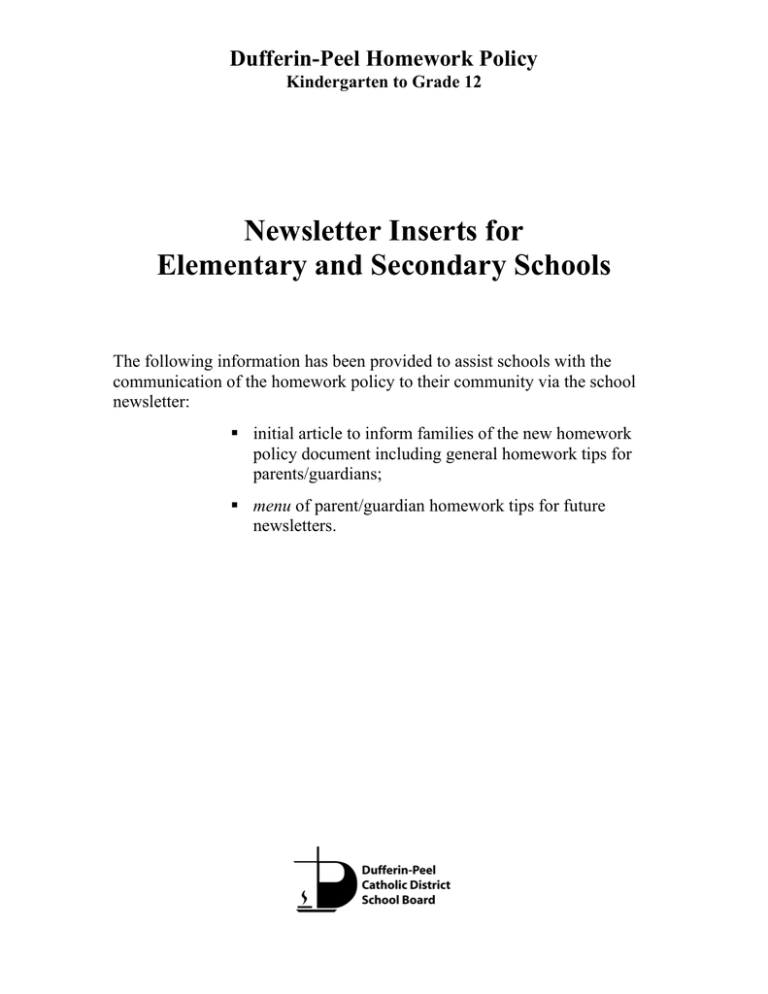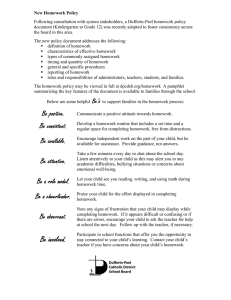Newsletter Inserts for Elementary and Secondary Schools Dufferin-Peel Homework Policy
advertisement

Dufferin-Peel Homework Policy Kindergarten to Grade 12 Newsletter Inserts for Elementary and Secondary Schools The following information has been provided to assist schools with the communication of the homework policy to their community via the school newsletter: initial article to inform families of the new homework policy document including general homework tips for parents/guardians; menu of parent/guardian homework tips for future newsletters. Initial Newsletter Insert New Homework Policy Following consultation with system stakeholders, a Dufferin-Peel homework policy document (Kindergarten to Grade 12) was recently adopted to foster consistency across the board in this area. The new policy document addresses the following: definition of homework characteristics of effective homework types of commonly assigned homework timing and quantity of homework general and specific procedures reporting of homework roles and responsibilities of administrators, teachers, students, and families. The homework policy may be viewed in full at dpcdsb.org/homework A summary of the key features of the document is available to families in the student agenda. Below are some helpful Be positive. Be’s to support families in the homework process: Communicate a positive attitude towards homework. Be consistent. Develop a homework routine that includes a set time and a regular space for completing homework, free from distractions. Be available. Encourage independent work on the part of your child, but be available for assistance. Provide guidance, not answers. Be attentive. Take a few minutes every day to chat about the school day. Listen attentively to your child as this may alert you to any academic difficulties, bullying situations or concerns about emotional well-being. Be a role model. Be a cheerleader. Let your child see you reading, writing, and using math during homework time. Praise your child for the effort displayed in completing homework. Be observant. Note any signs of frustration that your child may display while completing homework. If it appears difficult or confusing or if there are errors, encourage your child to ask the teacher for help at school the next day. Follow up with the teacher, if necessary. Be involved. Participate in school functions that offer you the opportunity to stay connected to your child’s learning. Contact your child’s teacher if you have concerns about your child’s homework. Additional homework tips will be featured in future newsletters. Additional Homework Tips for Future Newsletters Below is a menu of homework tips that schools may find helpful for future use in their monthly newsletters: Develop a positive attitude. It is important that family members come to an agreement on the positive value of homework. Gaining this consensus sets the stage for a successful learning environment within the home. Remember…the attitude you express about homework will be the attitude your child acquires. Designate a quiet working space. Distractions and homework do not mix. Provide a space for your child to do homework in an area that is free from distractions such as the television, computer games, friends, pets, and telephones, for example. Establish a routine. Consistency is a vital element in the learning process, especially for a child who needs structure. A homework schedule that includes a set time and space for completing homework reinforces the value of homework and becomes part of a regular routine. Create a ‘homework supply kit’. This kit can include materials that your child will use on a regular basis such as pencils, pens, ruler, paper, crayons, markers, glue, tape, scissors, sticky notes, paper clips, stapler, calculator, index cards, dictionary, thesaurus, etc. By having these supplies on hand, time is not wasted in searching for them when they are required. Provide guidance, not answers. Homework is a key way for your child to learn independent, lifelong skills. Giving answers regularly or doing homework for your child does not help him or her to understand concepts or develop skills. As well, it prevents the teacher from understanding where your child may require further support back in the classroom. If your child demonstrates signs of frustration with the homework being assigned, it is important to discuss this with your child’s teacher as soon as possible. Be a role model. Let your child see you reading, writing, using math, and doing other things that require thought and effort. For example, during your child’s homework time, consider doing some of your work such as paying bills, balancing a cheque book or reviewing a recipe. In this way, your child sees that the skills he or she is practising are related to things you do as an adult. Check in occasionally. A child’s concentration can wander, particularly when doing homework alone. Check in once in a while to see how your child is doing, to provide encouragement, to discuss a problem he or she may be encountering and/or to recommend a short break. Use everyday activities to support homework and learning. There may be times when homework has not been assigned. In these instances, you may wish to reinforce what your child is learning in school by involving them in everyday activities such as reading the newspaper, following a recipe, counting out change, creating shopping lists, writing a thank you card, designing an invitation or plotting out routes on a map, for example. Small activities such as these can often teach big lessons and provide you with opportunities to stay connected to your child’s learning. Reverse roles. Explaining to others is one of the best ways of reinforcing concepts. Try reversing roles – you play the role of the student and your child plays the role of the teacher. As your child explains the ‘lesson’, you can determine if he or she has understood the concept or if there are any misunderstandings that require clarification. Maintain a healthy balance. It is important to help balance the many activities in your child’s life school, homework, family commitments, religious celebrations, time with friends, part-time employment, and extra-curricular activities. Although it may be challenging, at times, to maintain this balance, it is essential to the health and well-being of the family. Know what’s going on at school. Your child may not always talk to you about everything that is happening at school. For this reason, it is important to take a few minutes every day to chat with your child about the school day, about what he or she has learned, about friends, about homework, and about any upcoming tests or assignments. Listen attentively to your child as this may alert you to any academic difficulties, bullying situations or concerns about general emotional well-being. Be a cheerleader. Encouragement helps build confidence. Take a moment at the end of a homework session to discuss the work that was just done and to review it for completion and understanding. Praise your child for his or her effort and find something positive to comment upon in the work. If it appears that the homework was difficult or confusing or if there are errors, encourage your child to ask the teacher for help at school the next day. Follow up with the teacher, if necessary. Be involved. Be informed. Homework plays an important role in strengthening the bond between the school and the family. Be involved in your child’s learning and stay informed by attending Open House activities and Parent-Teacher Conferences, for example. Use these opportunities to learn more about the expectations around your child’s homework and to discuss any concerns that you may have.






